Massage/manual therapy
Soft Tissue Mobilization
It is critical to recognize the role of muscles and their attachments around the joints. Muscle tension can often decrease once joint motion is restored, but often times the muscle hypertonicity can persist. In such cases, it is imperative to reduce the muscle tension to prevent joint dysfunction from returning. Soft tissue mobilization (STM) is to reduce inelastic or fibrous muscle tissue (known as ‘myofascial adhesions’) such as scar tissue from a back injury, move tissue fluids, and relax muscle tension. This procedure is commonly applied to muscles that encapsulate a joint, and consists of rhythmic stretching and deep pressure. Once identified, these restrictions can be mobilized with a wide variety of techniques. These techniques typically involve placing a traction force on the tight area with an attempt to restore normal texture to tissue and reduce associated pain.
Strain-Counterstrain
This technique focuses on correcting abnormal neuromuscular reflexes that cause structural and postural problems, resulting in painful ‘trigger points’. The therapist finds the patient’s position of comfort by asking the patient at what point the tenderness diminishes. This position of comfort is maintained for roughly 90-120 seconds, during which time asymptomatic strain is induced through mild stretching, and then slowly brought out of this position, allowing the body to reset its muscles to a normal level of tension. This normal tension in the muscles sets the stage for healing
Joint Mobilization
Patients often get diagnosed with a pulled muscle and are instructed to treat it with rest, ice and massage. While these techniques are useful and often feel good, the pain often returns because the muscle is spasming in response to a restricted joint. By mobilizing a joint we open up the joint space and increase its range of motion by providing slow velocity and increasing amplitude movement directly into the barrier of a joint.
Muscle Energy Techniques
Muscle energy techniques (Mets) are designed to mobilize restricted joints and lengthen shortened muscles. This procedure utilizes a voluntary contraction of the patient’s muscles against a controlled counterforce applied from the practitioner from a precise position and in a specific direction. Following a 5-10 second contraction, the operator takes the joint to its new limit where the patient again performs a muscle contraction. Muscle energy techniques are generally painless and provide no additional stress to the joint receiving treatment
High Velocity, Low Amplitude Thrusting
The procedure utilized to restore the accessory motion of joints, enabling them to open and close effectively. It is a more aggressive technique than joint mobilizations and muscle energy techniques that involves taking a joint to its restrictive barrier and thrusting into the restriction. When used appropriately this technique will result in an increase in mobility and a decrease in muscle tone around the joint. This technique is utilized for the restoration of joint motion and does not move a joint beyond its anatomical limit
Modalities
Transcutaneous Electrical Nerve Stimulation (TENS)
TENS units have been used to treat a litany of painful conditions. The success of this modality ranges greatly due to many factors including electrode placement, chronicity of the problem, and prior treatments. It is generally used in chronic pain conditions is rarely indicated for usage in the acute stage on an injury
Electrical Stimulation
E-Stim has been used in the acute stage of injuries to reduce muscle spasm and soft tissue edema, and pain. Its effect on muscle spasm and pain is felt by its counter-irritant effect, the effect on nerve conduction, and a reduction in muscle contractility. Use of electrical stimulation is often limited to the initial stages of treatment, such as the first week after the injury so that patients may quickly progress to more active treatment, which includes a restoration of range of motion and strengthening. It may often be combined with ice or heat to enhance its pain-reducing effects
Ultrasound
Ultrasound is a deep heating modality that is most effective in heating tissues of deep joints. It is typically not used in the acute stage of a condition where it can increase the inflammatory response. This modality is best used to reduce limitations in joint range of motion following recurrent or chronic joint pain as an adjunct in facilitating soft tissue mobilization and prolonged stretching by a skilled manual therapist.
Superficial Heat
Superficial heat can produce heating effects at a depth limited to 1-2cm. It has been found to be helpful in diminishing pain and decreasing local muscle spasms. Superficial heat should be used as an adjunct to facilitate an active exercise program. It is often utilized during the acute phases of treatment when the reduction of pain and inflammation are the primary goals. Superficial heat can be incorporated into the education program and utilized on a home basis as needed


Leave a Reply